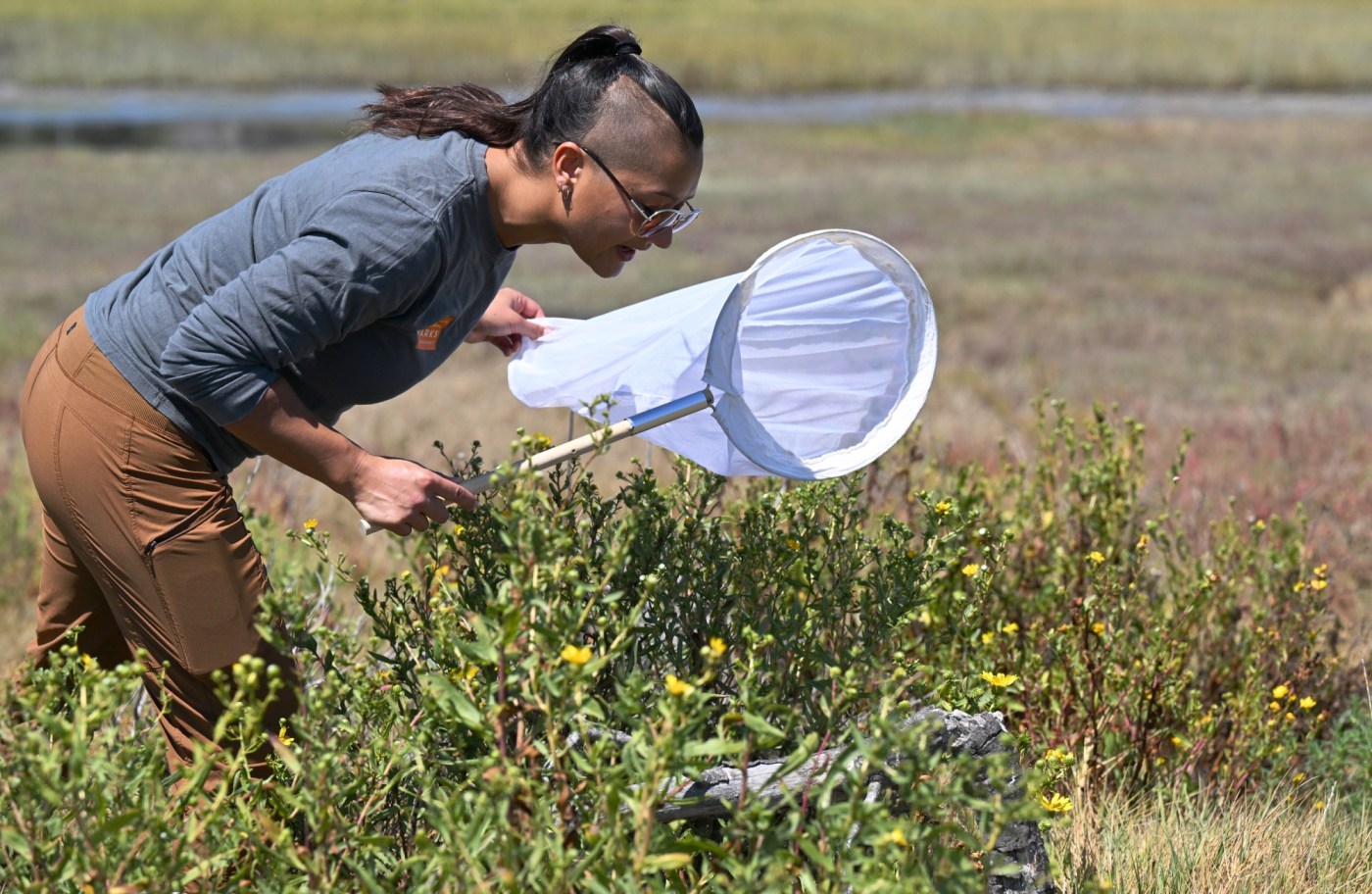A rare, elusive bee that is endemic to the Bay Area has turned up on Mount Tamalpais in its first documented sighting in nearly 45 years.
The San Francisco leaf-cutter bee, also known as Trachusa gummifera, was found as part of a One Tam community science effort to locate the fast-flying pollinator. The bee has been documented less than 100 times and has not been seen since 1980. The discovery could help fill in unknown details about its ecosystem.
The San Francisco leaf-cutter bee was documented on Mount Tamalpais in 2024 in its first sighting since 1980. (Sara Leon Guerrero/Golden Gate National Parks Conservancy)
“With this work, when you haven’t seen something for so long, you do expect that it’s going to be difficult to find it again,” said Sara Leon Guerrero of the Golden Gate National Parks Conservancy. “Oftentimes the reason we haven’t detected something or found it is because we aren’t looking for it.”
The One Tam partnership — a program that consists of the National Park Service, California State Parks, the Marin Municipal Water District, Marin County Parks and the parks conservancy — manages more than 60,000 acres of wooded habitat in Marin County.
Guerrero leads the Tamalpais Bee Lab. The lab, through the One Tam partnership, monitors and studies bees and other pollinators on the mountain.
From 2017 to 2022, the bee lab, in a collaboration with a lab at San Francisco State University, created a bee survey in the Mount Tamalpais area. The project also included a historical species list and groups of bees to keep an eye out for, either because of their presumed range expansion, their rarity or because they were documented in the area at some point. The list included the San Francisco leaf-cutter bee.
“When the experts tell you to go look at something, you’re like, OK, maybe we should go check it out,” Guerrero said.
The bee is identified as a species of greatest conservation need in California’s wildlife plan. There are more than 1,600 bee species in California, and an estimated 300 to 400 in Marin County, according to Guerrero.
Carl Sanders, the natural resources program manager with the Marin Municipal Water District, said the discovery is fascinating because it could provide information on how to best manage the land on Mount Tamalpais.
“It’s a very helpful sign to find a species, any species — in this case a very tiny, elusive ground nesting bee that hasn’t been seen or heard from in decades — it’s a hopeful sign that the lands we’re currently stewarding across the different agencies, that we’re doing it appropriately,” Sanders said.
Little information about the bee exists beyond a general description, the types of plants it frequents and its general range. Still, Guerrero read up on everything she could. The solitary bees collect resin from conifers trees in the area, and use leaves to create the brood cells. The team would be looking for the bees around fresh sap and for little oval or circular cutouts in leaves.
She presented the idea to One Tam to dedicate some time and community research volunteers to search for the bee. The organization gave her the green light.
“They were very excited,” Guerrero said. “It’s not often that you get to do single-species work, but this species kind of tells us about the greater ecosystem it exists within.”
The search party was created in the spring. The team was doing some preliminary site visits near the southern to middle part of the Lagunitas Creek watershed. On the first day, Guerrero posted up near a chaparral pea plant — a purple flowering plant the bee had been documented visiting in the past — and was thinking about a search plan when something caught her eye.
“I saw a very fast-flying bee go by and I was like, it can’t be that bee,” Guerrero said.
Just in case, she grabbed her net and caught it after a few tries. She put the bee in a sterile vial and placed it in a cooler on ice — a harmless technique that puts the bee in a calming, sleeplike state.
“As I’m taking photos of this bee, I’m going: Oh my gosh, oh my gosh,” Guerrero said.
The next day, a taxonomist with the U.S. Department of Agriculture confirmed the bee was a male Trachusa gummifera.
“I think it’s a very hopeful story,” Guerrero said. “Sometimes things that we presumed are in trouble or presumed missing, we may just not be out there at the right time or place to document them.”
Max Korton, director of the Marin County parks department, said the discovery will provide a better understanding of how key species in Marin are doing, how its ecosystems are adapting to a changing climate and how to best manage these areas.
“This discovery is so cool,” Korton said. “Finding a rare insect, flower or amphibian is also inspiring to us and the community. The more we learn about the complexity and richness of our natural systems, the more we are inspired to care for them.”
While the prime season for bee-related work has wrapped up, Guerrero said the next steps are to work with the state’s Department of Fish and Wildlife to get permits needed to study the bee further. Guerrero hopes to fill in some gaps in its life history, habitat preferences and phenology.
Sanders said the district is working on securing funding from the Department of Fish and Wildlife to bolster monitoring efforts of the species. He said the bee has now been spotted at several sites, and any information gained from studying the bee will guide land management activities.
“It’s a powerful symbol in my mind as well as just one more piece of missing information about our local natural web,” Sanders said.
Guerrero said that without the volunteers in the community science program, exciting findings like this would not be possible, especially with so many bees and not enough staff and scientists to go around.
“Without the idea of like we can go out there with volunteers to just look, because no one’s looking, this discovery wouldn’t have happened,” Guerrero said. “So moving forward, the things we’re going to learn are going to be done with community science.”












